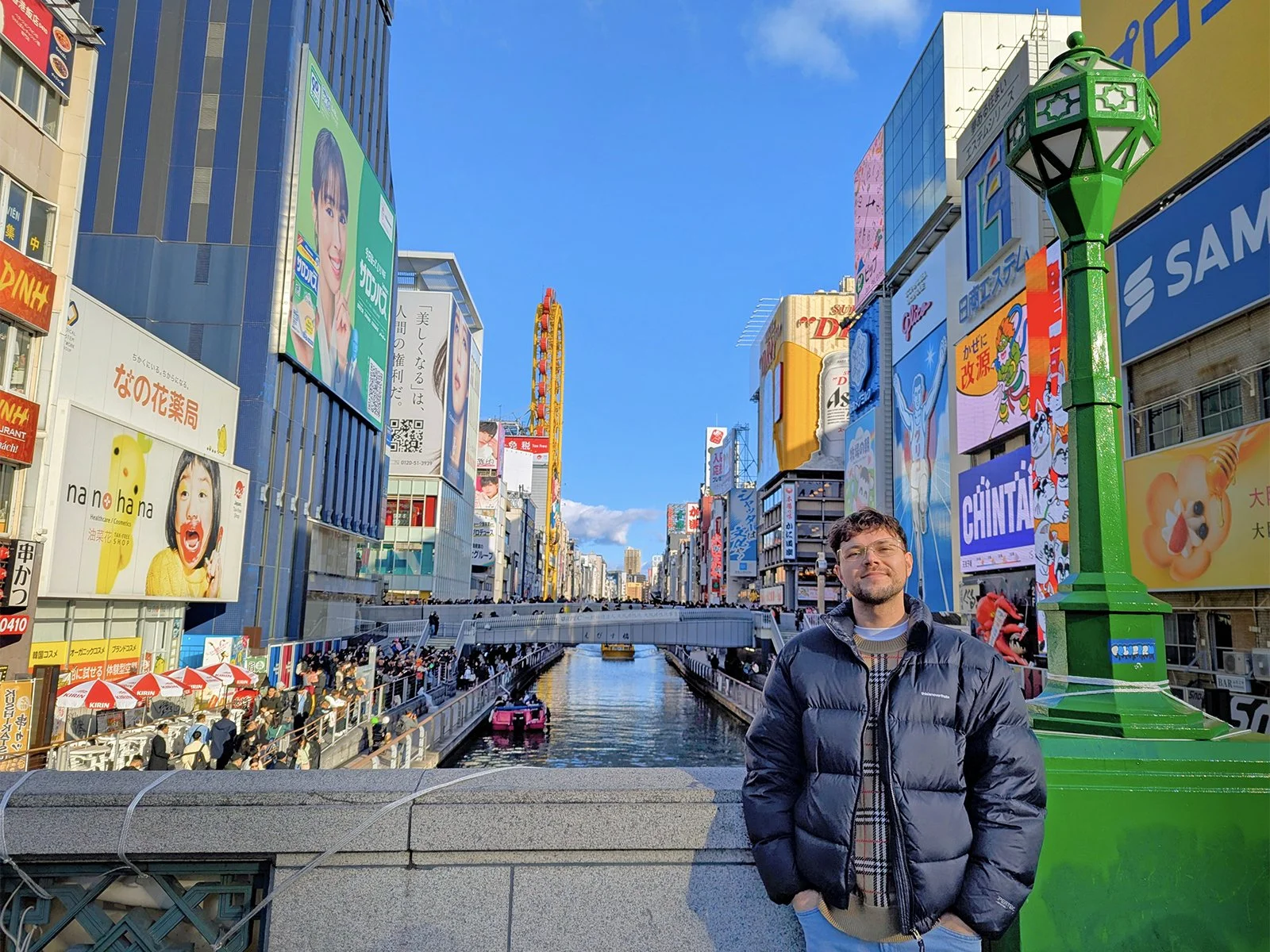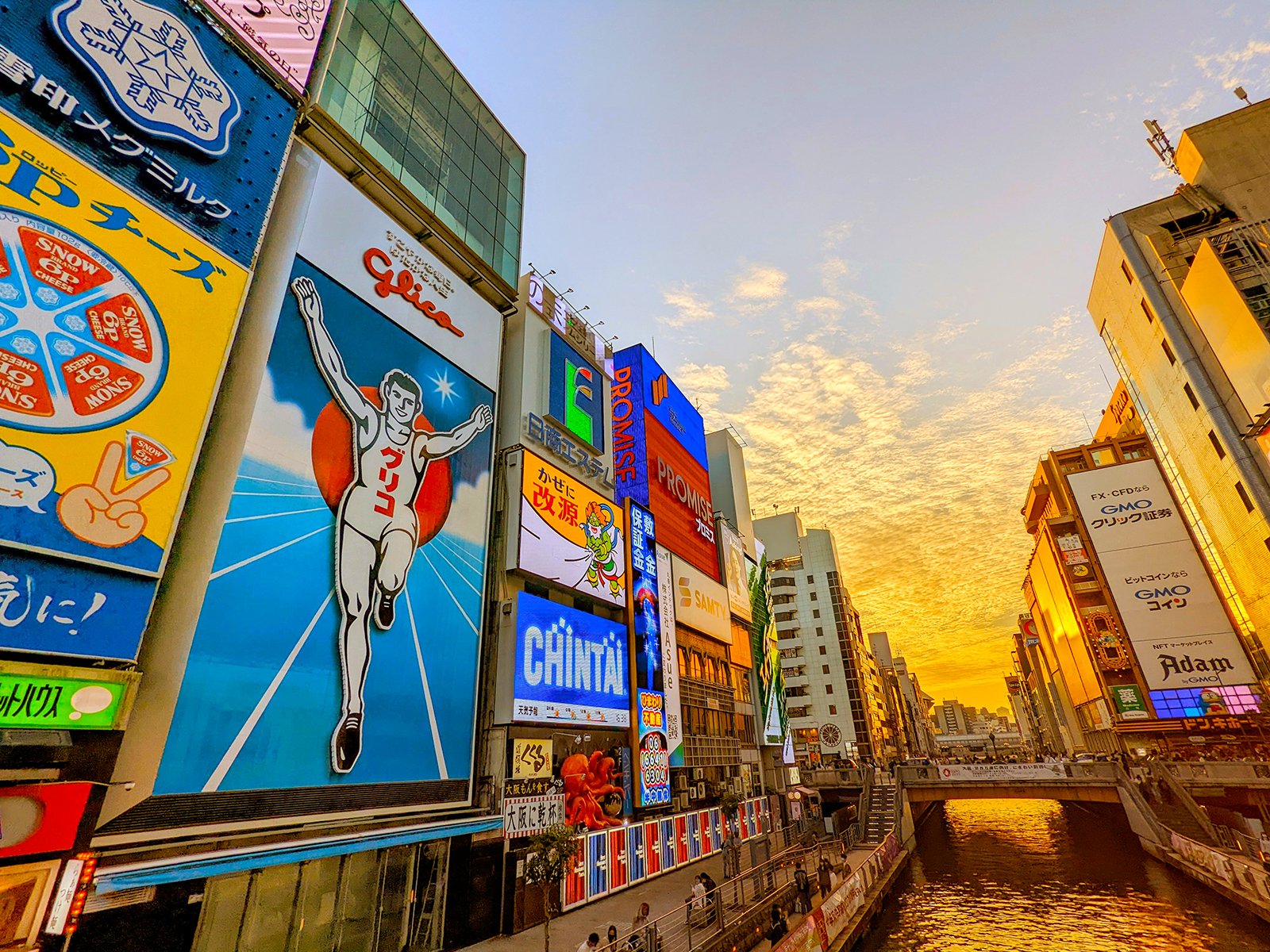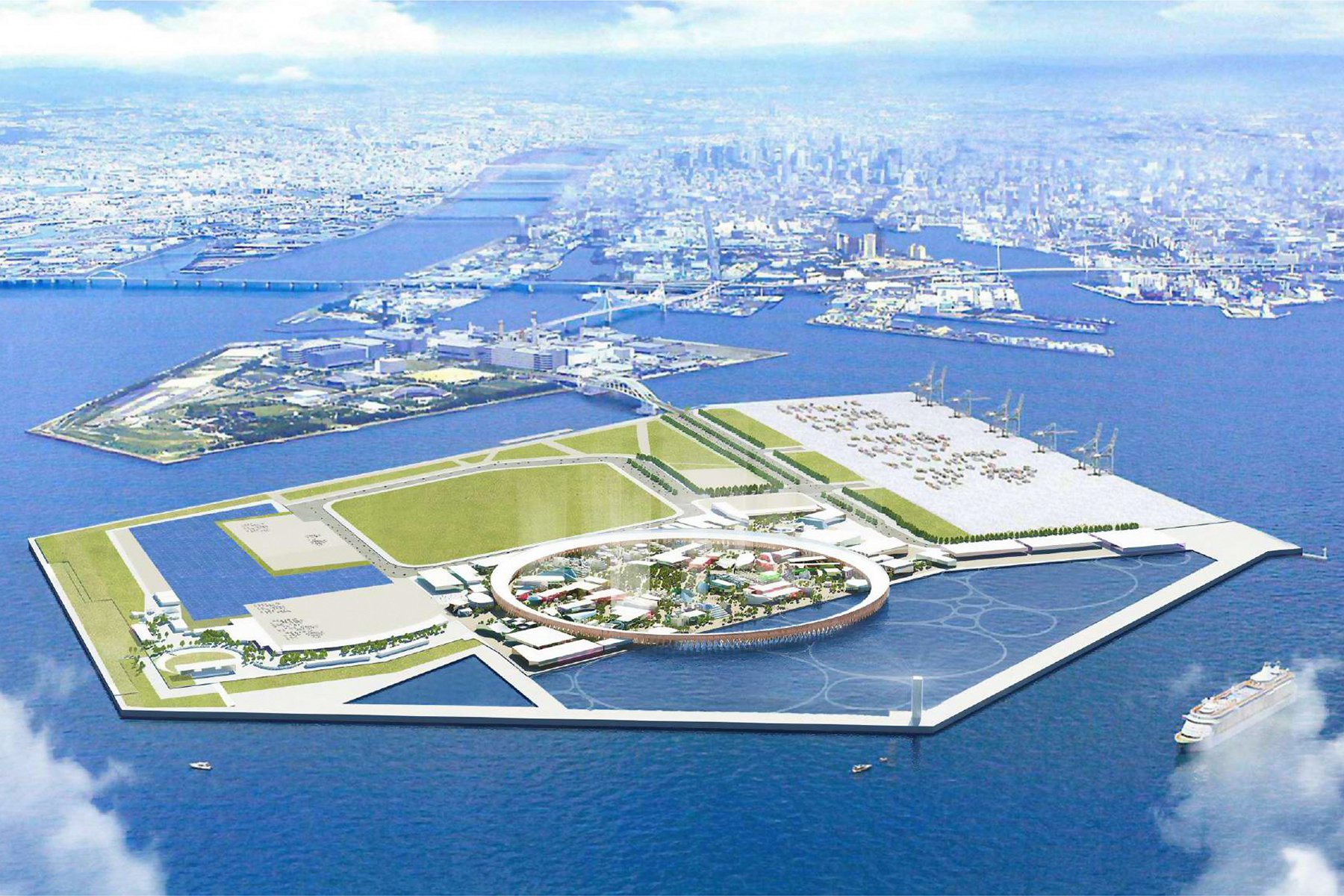Travel Guide: Osaka

Japan’s western hub is famous for riverways, fried food, and entertainment.
Cover photo: Posing at Dotonbori, with Ebisu Tower Ferris Wheel and Glico Running Man in the background, Osaka, Japan (2025).
Click on an image for more information.
Intro
Big, bold, and bursting with flavor — Osaka is often called Japan’s friendliest city. As the nation’s western hub, this lively metropolis offers world-class attractions, stylish shopping streets, and endless nightlife options. It’s also compact, affordable, and easy to navigate, making it a perfect base for exploring the beautiful Kansai region.
Osaka is my favorite big city in Japan, boasting impressive temples, theme parks, contemporary art, and mouthwatering street food. And with new attractions opening ahead of Expo 2025, now is the perfect time to visit!
History
First known as ancient Naniwa (難波京), Osaka (大阪) — “The Large Hill” — was settled upon the wetlands of the Yodogawa Delta, fed by the mighty river running from Lake Biwa to Osaka Bay.
Daimyo (feudal lord) Toyotomi Hideyoshi (豊臣 秀吉) established Osaka Castle in the 16th century. At his order, Osaka’s first canals were dug as defensive moats, transportation arteries, and sewage drains. The city’s famous entertainment district Dotonbori was also developed at this time.
From the Meiji Era (1868 - 1912), Osaka was at the forefront of Japan’s industrial revolution. As a result, it was devastated in World War II, with a third of the city destroyed by American air raids. In 1970, it was the first city in Asia to host the World Expo. Today, Osaka is Japan’s third-largest city.
Cuisine & Alcohol
As a flourishing merchant city and transportation hub, Osaka has been called “Tenka no Daitokoro” (天下の台所) or “Kitchen of the Nation” since the Edo Period (1603 - 1868). Today, Osaka is especially famous for fried foods such as takoyaki (fried octopus dumplings), okonomiyaki (savory noodle pancakes) and kushikatsu (skewers). Osaka is also the birthplace of instant ramen, invented by Taiwanese-born Momofuku Ando (安藤 百福) in 1958.
I suggest dining at Fukutaro Main Store for okonomiyaki, but expect a wait. I also recommend 551 Horai, a local food chain famous for Chinese butaman (pork buns). My favorite restaurant is Obon Shokudo 16, offering traditional Japanese cuisine. The grilled cod in white miso is delicious. Kitte Osaka is also worth a visit as the second floor hosts products from across Japan, including soft-serve ice cream from Hokkaido.
Both brands Asahi Breweries and Suntory are from Osaka, with Asahi Brewery (beer) in Suita and the Suntory Yamazaki Distillery (whiskey) open to the public — reservations required.
Osaka’s varied bar scene includes izakaya (local pubs), themed bars, and luxe lounges. My favorites are Gucci Giardino for creative cocktails, American Prohibition era-inspired Bible Club, and Bar Bota at the Four Seasons with a view of Osaka Castle. Canes & Tales at the new Waldorf Astoria is also worth a mention, overlooking Umekita Park and Osaka Station.
Dotonbori
Osaka’s top attraction is Dotonbori, a canal-side entertainment district famous for extravagant storefronts and neon lights. It’s a unique sight, overwhelming the senses with bustling crowds and intoxicating smells. Pose for a photo with the iconic Glico Running Man sign or take a ride on the world’s only oblong Ferris wheel. Avoid the suffocating weekend crowds, if possible.
Dotonbori is most popular for shopping, with Japanese and international brands available throughout Shinsaibashi-suji Shopping Street. Adjoining department stores Daimaru and Parco feature a Ghibli Store, Pokémon Center, and other character shops. Don’t miss Kohei Nawa’s phoenix sculptures! To the west is Ame-Mura, or American Village, an area great for secondhand clothing.
Art & Culture
Osaka hosts frequent blockbuster art exhibitions. Check online for the latest information. I suggest visiting the Nakanoshima Museum of Art or National Museum of Art in Osaka. After a years-long renovation, the Osaka Municipal Museum of Fine Arts reopened in March of this year. Espace Louis Vuitton Osaka also hosts interesting shows, with free entry.
TeamLab’s Botanical Garden at Nagai Park is another highlight. The outdoor setting is beautiful and an altogether different experience from the collective’s indoor spaces in Tokyo.
I also recommend the Osaka Museum of History — which offers a beautiful view of Osaka Castle — and the National Museum of Ethnology at Expo Park. Art lovers must visit Taro Okamoto’s Tower of the Sun, built for the exposition in 1970 and reopened in 2018.
While Osaka’s temples are less famous than those in neighboring Kyoto, the city has its own historic sites. Shitennoji (“Temple of Four Heavenly Kings”) is one of Japan’s oldest Buddhist temples and the main hall features beautiful murals. Sumiyoshi Taisha has a beautiful drum bridge and northern Katsuoji boasts a vibrant collection of red Daruma dolls. Namba Yasaka Shrine is famous for its hall in the shape of a lion head.
Entertainment
Universal Studios Japan (USJ) is one of the busiest theme parks in the world and a major highlight thanks to Super Nintendo World and unique anime attractions. Pro-tip: the best days to visit are Wednesday or Thursday for shorter lines. Buy tickets in advance.
Featuring whale sharks, Osaka’s Kaiyukan (Aquarium) is another popular site — reservations recommended. I also suggest the hot spring resort Solaniwa Onsen for a relaxing time.
For traditional culture, consider purchasing tickets to a Kabuki show at Shochikuza or puppetry at the National Bunraku Theater. Osaka is also one of four cities to host sumo wrestling, taking place in March. The new Sumo Hall Hirakuza offers shows year-round.
View of winter illuminations decorating Midosuji Avenue from the observation deck WowUs at Dojihama Tower, Osaka, Japan (2024). Photo by Danny With Love.
Events & Seasons
Osaka’s biggest event is Tenjin Matsuri (“Festival of the Gods”) which includes a mikoshi (portable shrine) parade, boat procession, and fireworks. Held annually on July 24th and 25th, it’s one of Japan’s three major festivals.
Other popular events include Yodogawa Fireworks and the Summer Sonic rock music festival (both in August), as well as Kishiwada Danjiri Matsuri — a traditional float festival — in September.
Minoh National Park is especially popular for fall foliage, usually best around mid-November. Osaka rarely sees snow but the winter season is nonetheless lively. Osaka’s Midosuji Street boasts the world’s longest tree illuminations!
Osaka Castle Park and Expo Park are popular year-round, with seasonal flowers, illuminations, and special events. For sakura (cherry blossom) season, I also recommend visiting Osaka Mint Bureau — reservations required.
LGBT+
Osaka’s gay district is centered around Doyamacho, near Umeda. Note: unlike Tokyo’s dense Shinjuku Nichome, Doyamacho is a general nightlife area with many gay bars to choose from.
My favorite is the new Eagle Osaka, with a small dance floor open on Saturdays; cash is not accepted, but you can pay with a metro card. Explosion offers karaoke and hosts frequent events. For a unique experience, I recommend Osaka Rokuten, a sake bar where guests are invited to wear fundoshi (Japanese loincloths) — men only. For drag shows, visit Do With Cafe.
Kansai Rainbow Festa — Western Japan’s biggest annual pride event — takes place mid-October in Ogimachi Park. Though smaller than Tokyo Rainbow Pride, it’s a lovely event featuring great performers, vendors, and a parade.
Transportation & Accommodation
Osaka is primarily served by Kansai International Airport (KIX), approximately one hour south. Shin-Osaka Station is about 2.5 hours from Tokyo by the Tokaido Shinkansen (bullet train) — flying may be cheaper.
The city boasts a wonderful public transit system, consisting of metro and buses. Japan’s taxis are comparatively expensive. Go and DiDi are popular ride-hailing apps.
Most tourists stay around Dotonbori (Namba / Shinsaibashi), though I prefer Umeda as it’s cheaper and closer to nightlife in Doyamacho. Pro-tip: budget travelers can find great accommodation deals north or south of the city — stay near the Midosuji Line.
Top Attractions
Dotonbori (street food and shopping area)
Osaka Castle Park & Osaka Museum of History
Universal Studios Japan (theme park)
teamLab Botanical Garden (immersive art experience)
Shitennoji (Osaka’s oldest temple)
Kaiyukan (aquarium with whale sharks)
Solaniwa Onsen (bathhouse resort)
Osaka Expo Park & National Museum of Ethnology
Abeno Harukas (skyscraper with observation deck)
Nakanoshima Museum of Art
Tsutenkaku / Shinsekai (landmark retro tower)
Additional Ideas
As Japan’s western hub, Osaka can serve as a base for exploring the Kansai region, which includes Kyoto, Nara, and Kobe. UNESCO World Heritage sites Himeji Castle and the Mozu-Furuichi Tombs are also accessible from the city.





























